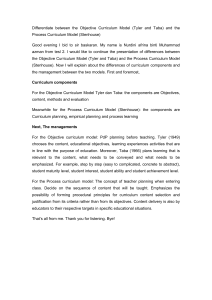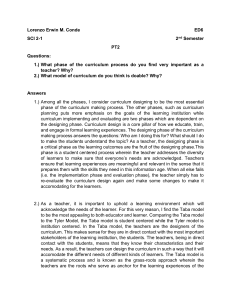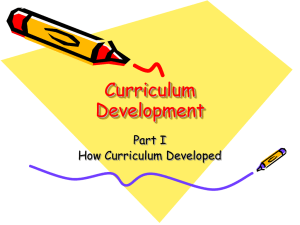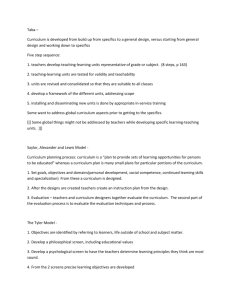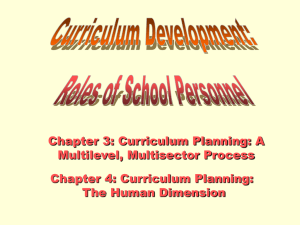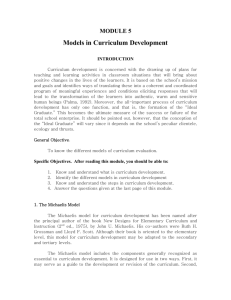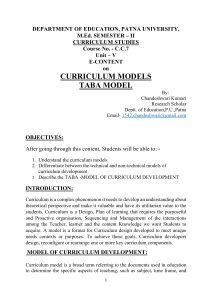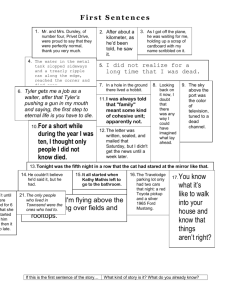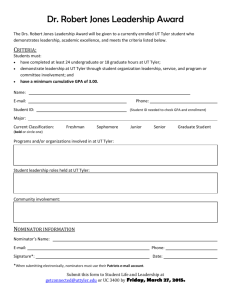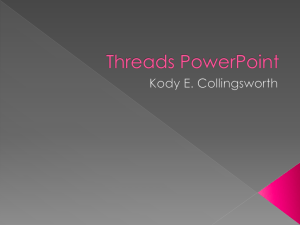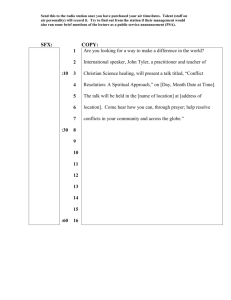EDU555 Week 3
advertisement
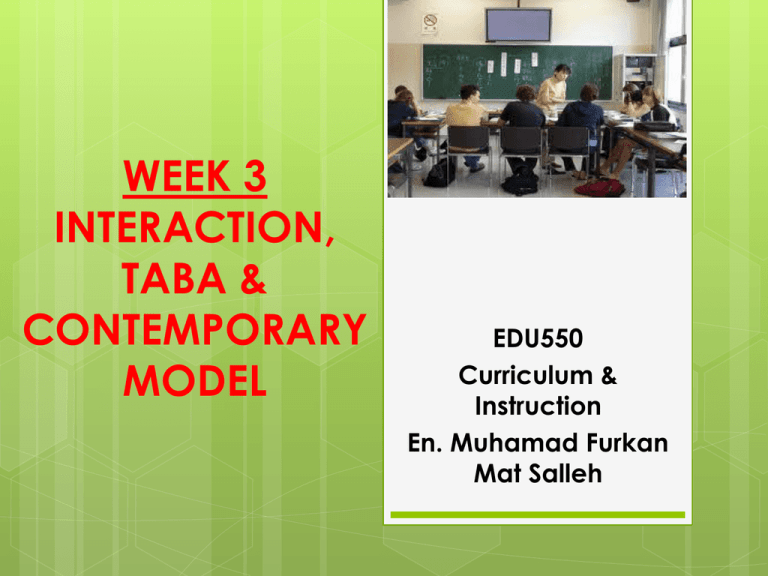
WEEK 3 INTERACTION, TABA & CONTEMPORARY MODEL EDU550 Curriculum & Instruction En. Muhamad Furkan Mat Salleh Interaction Model Also known as Dynamic Model To overcome the weaknesses of the Tyler’s Model, Taba (1962) and Cohen proposed a more dynamic process of curriculum development It In is a modification of the Tyler’s Model this model, curriculum development is seen as a dynamic process Interaction Model It may begin with any of the four curriculum element i.e. objectives, contents, methods, evaluation and these elements can be followed in any sequence OBJECTIVES EVALUATION CONTENTS METHODS Interaction Model Do not follow the order or sequence as in Tyler’s Model. The four elements are regarded as interactive and modifiable i.e. changes can be made at any time. A change made to one element will similarly cause changes to the other elements. The CD process becomes flexible and dynamic. Interaction Model Strengths: Practical Represent a true picture of curriculum development The Interaction Model is practical and flexible and can be appropriately used to design the curriculum. Flexible Allows the curriculum developer to: Change the order of planning, and thus, not restricted by a fixed procedure. React to learning situations in determining the sequence to follow according to the curriculum element. Interaction Model Weaknesses: No fixed objectives: By not stating objectives first, the objectives may be accommodated to suit the contents. As a result, the objectives are not in line with the initial objectives. No fixed direction Continuous changing of direction during the process of curriculum development will result in a disorganised curriculum. Hilda Taba • • • • • • • A curriculum theorist, a curriculum reformer, and a teacher educator. Bachelor degree in English and Philosophy at Tartu University. Master degree Bryn Mawr College in Pennsylvania, Doctoral studies in educational philosophy at Columbia University. Curriculum director at the Dalton School in New York City. Curriculum Development: Theory and Practice (1962). Co-coordinator of the social studies curriculum – University of Ohio – University of Chicago TABA’S MODEL Taba’s Model (Hilda Taba, 1962) Most suitable model for language program Based on the Objective Model or Tyler’s Model (Ralph Tyler, 1950) Prominent model for curriculum development and widely used as a reference TABA’S MODEL Also known as “Grass-roots approach Based on the rationale that those who teach the curriculum i.e. the teacher, should participate in developing the curriculum. Teacher should have major input in curriculum development. Agreed with Tyler that there should be a definite order in developing the curriculum to facilitate attaining a more thoughtful and dynamically conceived curriculum. TABA’S MODEL Steps or stages in curriculum development are almost similar to Tyler’s Model. The main difference is in the need to carry out a diagnosis of needs in Taba’s Model. Inductive approach – start with specifics to a general design. i.e. teachers start by creating teaching – learning units for the students, then narrow down to objectives. TABA’S MODEL 7 Steps of Taba’s Model DIAGNOSIS OF NEEDS SELECTION OF OBJECTIVES SELECTION OF CONTENT ORGANIZATION OF CONTENT SELECTION OF LEARNING EXPERIENCES ORGANIZATION OF LEARNING EXPERIENCES DETERMINING OF WHAT TO EVALUATE AND HOW TO EVALUATE IT TABA’S MODEL 7 major steps: 1. Diagnosis of Needs: Begin by identifying the needs of the students for whom the curriculum is planned. 2. Formulation of Objectives: Specify objectives to be accomplished. 3. Selection of Content: Match content and objectives. 4. Organisation of Content: Organise content in a sequence, taking into account the maturity of the learners, their academic achievement and their interests. TABA’S MODEL 5. Selection of Learning Experiences: Teacher selects learning experiences and methods that will involve the students with the content. 6. Organisation of Learning Experiences: Sequence and organise learning activities. 7. Evaluation and Means of Evaluation: Determine how objectives are to be accomplished and what have been accomplished. CONTEMPORARY MODEL OR FRAMEWORK OF CURRICULUM DEVELOPMENT Curriculum Development Based on 3 models of curriculum development, the contemporary model or framework of curriculum development involves 5 steps: 1) Needs analysis 2) Formulating Objectives 3) Selecting and organizing content 4) Implementing the curriculum 5) Evaluating the curriculum Contemporary Model Needs Analysis Objectives Feedback Contents Implementation Evaluation Curriculum Development 1) Needs analysis It may include analyzing the needs of: Students Graduates Employers Industry Stakeholders National and global development Curriculum Development 2) Formulation of objectives Could be formulated from the needs/opinions of: Lecturers Industries Students Global National Social Curriculum Development 3) Selection of Content Sources of content: Lecturers SME External examiners Employers Accreditation bodies Politicians IHL Students Academic advisors Professional bodies Alumni, graduates Government policies Academicians Comparison and benchmarking Curriculum Development 3) Selection of Content Consider: Breadth and depth Relevance and Adequacy Balance between knowledge, skills and attitude Curriculum Development 4) Implementation Teaching and learning process - Teaching styles and strategies - Learning styles and strategies Curriculum Development 5) Evaluation Determine the method to measure whether the curriculum is achieving the desired objectives or results It involves an appraisal of the students’ actual behaviour It should be carried out at several different times to secure evidence of the permanence of the learning achieved 5) Evaluation Using a variety of methods e.g. tests, work samples, questionnaires, records, etc. Results should be used to: indicate strengths and weaknesses of the program to plan for revision THANK YOU
